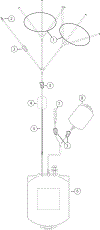In vitro quality parameters of whole blood-derived platelets pooled using two different platelet pooling sets and stored up to 7 days are similar
- PMID: 37991217
- PMCID: PMC12163364
- DOI: 10.1111/trf.17591
In vitro quality parameters of whole blood-derived platelets pooled using two different platelet pooling sets and stored up to 7 days are similar
Abstract
Background: Increasing the number of collections of whole blood-derived platelets (WBDP) and lengthening the allowable storage time may alleviate platelet (PLT) shortages. There is a need for new PLT pooling sets that can provide acceptable quality on Day 7 of storage.
Study design and methods: This pool-and-split study compared WBDP prepared using the platelet-rich plasma method with the novel IMUGARD WB PLT pooling set and a control pooling set. After pooling and filtration, PLT products were tested on Days 1, 5, and 7. Large volume delayed sampling (LVDS) cultures were taken on Day 2.
Results: The median postfiltration residual white blood cell (rWBC) content was 0.18 million per product (maximum 1.26 million; n = 69) with mean PLT recovery of 88.5 ± 2.8% for the new set and median 0.23 million (maximum 1.83 million) rWBC with 87.5 ± 2.5% recovery for the control. Day 5 mean pH22°C were 7.18 ± 0.12 and 7.13 ± 0.10 for the new and control set, respectively. Day 5 in vitro quality parameters were within 20% between the two pooling sets. The new set Day 7 pH22°C was acceptable (7.07 ± 0.17, 100% ≥ 6.3), and most parameters were within 20% of Day 5 values.
Conclusion: WBDP quality for the new pooling set is acceptable across a battery of in vitro tests when stored up to 7 days and meets FDA regulatory criteria. The quality parameters were similar between the new pooling set and the control set on Day 5. This new set is compatible with LVDS.
Keywords: PRP; platelet storage; platelet-rich plasma; pooled platelets.
© 2023 AABB.
Conflict of interest statement
CL, KC, CT, SN, SN, and NR have disclosed no conflicts of interest. TV, CG, and TW are current or former employees of Terumo BCT. LJD is the employee of Vitalant Research Institute, a consultant for Terumo BCT, and a consultant Hemanext. LS involved in affiliation with Carter Bloodcare, reimbursement for labor, and supplies associated with this study. FC is the employee of Carter Bloodcare, compensation for labor, and supplies associated with this study. JAC is the employee of University of Cincinnati; recipient of research grants from Cerus Co., HHS BARDA, US DoD, National Institute of Health, Cellphire Inc., Vascular Solutions Inc/Teleflex, Velico Medical Inc, Terumo BCT, and Fresenius Kabi; consultant Vascular Solutions Inc/Teleflex; scientific advisor Hemanext; president, co-founder, co-owner of Platefuse Inc.; equity owner and scientific advisor of Preservation Bio.
Figures


References
-
- Stubbs JR, Homer MJ, Silverman T, Cap AP. The current state of the platelet supply in the US and proposed options to decrease the risk of critical shortages. Transfusion. 2021;61:303–12. - PubMed
-
- Mintz PD, Sanders JR. Outdate reduction and cost savings with rapid testing for seven-day platelet storage. Ann Clin Lab Sci. 2020;50:404–7. - PubMed
-
- U.S. Food & Drug Administration. Bacterial Risk Control Strategies for Blood Collection Establishments and Transfusion Services to Enhance the Safety and Availability of Platelets for Transfusion. December 2020.
-
- Holme S, Moroff G, Murphy S. A multi-laboratory evaluation of in vitro platelet assays: the tests for extent of shape change and response to hypotonic shock. Biomedical excellence for safer transfusion working Party of the International Society of blood transfusion. Transfusion. 1998;38:31–40. - PubMed
MeSH terms
Grants and funding
LinkOut - more resources
Full Text Sources
Research Materials

